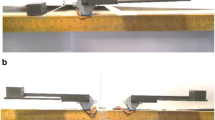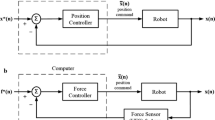Abstract
This study investigated a previously unaccounted for source of error in a high-capacity, six degree-of-freedom load cell used in multi-degree-of-freedom robotic testing of musculoskeletal joints, an application requiring a load cell with high accuracy in addition to high load capacity. A method of calibration is presented for reducing the error caused by changes in universal force-moment sensor (UFS) orientation within a gravitational field. Uncorrected, this error can exceed a magnitude of 1% of the full-scale load capacity—the manufacturer-stated accuracy of the UFS. Implementation of the calibration protocol reduced this error by approximately 75% for a variety of loading conditions. This improvement in load cell accuracy (while maintaining full load capacity) should improve both the measurement and control of specimen kinetics by robotic/UFS and other biomechanical testing systems. © 1999 Biomedical Engineering Society.
PAC99: 8719Rr, 8780Vt, 0620Fn, 0620Dk, 8719Ff
Similar content being viewed by others
REFERENCES
Buchanan, T. S., and D. G. Lloyd. Muscle activation at the human knee during isometric flexion-extension and varusvalgus loads. J. Orthop. Res. 15:11–17, 1997.
Carlin, G. J., G. A. Livesay, C. D. Harner, Y. Ishibashi, H. S. Kim, and S. L.-Y. Woo. In situ forces in the human posterior cruciate ligament in response to posterior tibial loading. Ann. Biomed. Eng. 24:193–197, 1995.
Cobbold, R. S. C. Transducers for biomedical measurements: Principles and applications. New York, Wiley, 1974, p. 486.
Fujie, H., G. A. Livesay, S. L-Y. Woo, S. Kashiwaguchi, and G. Blomstrom. The use of a universal force-moment sensor to determine in situ forces in ligaments: A new methodology. J. Biomech. Eng. 117:1–7, 1995.
Fujie, H., K. Mabuchi, S. L.-Y. Woo, G. A. Livesay, S. Arai, and Y. Tsukamoto. The use of robotics technology to study human joint kinematics: A new methodology. J. Biomech. Eng. 115:211–217, 1993.
JR3, Inc. Universal force-moment sensor system operation manual (Revision 2.0a), copyright 1988. JR3, Inc., Woodland, CA, 1988.
JR3, Inc. JR3 universal force-moment sensor system spec sheet (April 7, 1992). JR3, Inc., Woodland, CA, 1992.
Kirsch, R. F., A. M. Acosta, E. J. Perreault, and M. W. Keith. Measurement of isometric elbow and shoulder moments: Position-dependent strength of posterior deltoid-to-triceps muscle tendon transfer in tetraplegia. IEEE Trans. Rehabil. Eng. 4:403–409, 1996.
Kirsch, R. F., and R. E. Kearney. Identification of time-varying dynamics of the human triceps surae stretch reflex. II. Rapid imposed movement. Exp. Brain Res. 97:128–138, 1993.
Kirsch, R. F., R. E. Kearney, and J. B. MacNeil. Identification of time-varying dynamics of the human triceps surae stretch reflex. I. Rapid isometric contraction. Exp. Brain Res. 97:115–127, 1993.
Livesay, G. A., H. Fujie, S. Kashiwaguchi, D. A. Morrow, F. H. Fu, and S. L-Y. Woo. Determination of the in situ forces and force distribution within the human anterior cruciate ligament. Ann. Biomed. Eng. 23:467–474, 1995.
Norton, H. N. Handbook of Transducers. Englewood Cliffs, NJ: Prentice-Hall, 1989, p. 554.
Rudy, T. W., G. A. Livesay, S. L-Y. Woo, and F. H. Fu. A combined robotic/universal force sensor approach to determine in situ forces of knee ligaments. J. Biomech. 29:1357–1360, 1996.
Yoganandan, N., J. F. Cusick, F. A. Pintar, K. Droese, and J. Reinartz. Cyclic compression-flexion loading of the human lumbar spine. Spine 19:784–791, 1994.
Author information
Authors and Affiliations
Rights and permissions
About this article
Cite this article
Gilbertson, L.G., Doehring, T.C., Livesay, G.A. et al. Improvement of Accuracy in a High-Capacity, Six Degree-of-freedom Load Cell: Application to Robotic Testing of Musculoskeletal Joints. Annals of Biomedical Engineering 27, 839–843 (1999). https://doi.org/10.1114/1.236
Issue Date:
DOI: https://doi.org/10.1114/1.236




